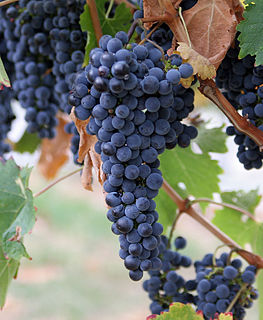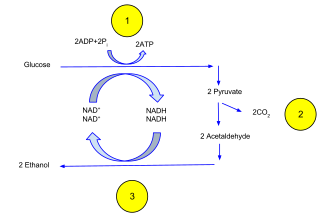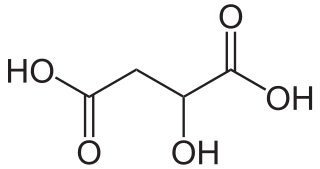
Carbonic maceration is a winemaking technique, often associated with the French wine region of Beaujolais, in which whole grapes are fermented in a carbon dioxide rich environment prior to crushing. Conventional alcoholic fermentation involves crushing the grapes to free the juice and pulp from the skin with yeast serving to convert sugar into ethanol. Carbonic maceration ferments most of the juice while it is still inside the grape, although grapes at the bottom of the vessel are crushed by gravity and undergo conventional fermentation. The resulting wine is fruity with very low tannins. It is ready to drink quickly but lacks the structure for long-term aging. In the most extreme case, such as with Beaujolais nouveau, the period between picking and bottling can be less than six weeks.

Red wine is a type of wine made from dark-colored (black) grape varieties. The actual color of the wine can range from intense violet, typical of young wines, through to brick red for mature wines and brown for older red wines. The juice from most purple grapes is greenish-white, the red color coming from anthocyan pigments present in the skin of the grape; exceptions are the relatively uncommon teinturier varieties, which produce a red-colored juice. Much of the red-wine production process therefore involves extraction of color and flavor components from the grape skin.
Maceration is the winemaking process where the phenolic materials of the grape—tannins, coloring agents (anthocyanins) and flavor compounds—are leached from the grape skins, seeds and stems into the must. To macerate is to soften by soaking, and maceration is the process by which the red wine receives its red color, since raw grape juice is clear-grayish in color. In the production of white wines, maceration is either avoided or allowed only in very limited manner in the form of a short amount of skin contact with the juice prior to pressing. This is more common in the production of varietals with less natural flavor and body structure like Sauvignon blanc and Sémillon. For Rosé, red wine grapes are allowed some maceration between the skins and must, but not to the extent of red wine production.
A wine fault or defect is an unpleasant characteristic of a wine often resulting from poor winemaking practices or storage conditions, and leading to wine spoilage. Many of the compounds that cause wine faults are already naturally present in wine but at insufficient concentrations to be of issue. In fact, depending on perception, these concentrations may impart positive characters to the wine. However, when the concentration of these compounds greatly exceeds the sensory threshold, they replace or obscure the flavors and aromas that the wine should be expressing. Ultimately the quality of the wine is reduced, making it less appealing and sometimes undrinkable.

A stuck fermentation occurs in brewing beer or winemaking when the yeast become dormant before the fermentation has completed. Unlike an "arrested fermentation" where the winemaker intentionally stops fermentation, a stuck fermentation is an unintentional and unwanted occurrence that can lead to the wine being spoiled by bacteria and oxidation. There are several potential causes of a stuck fermentation-the most common are excessive temperatures killing off the yeast or a must deficient in the nitrogen food source needed for the yeast to thrive. Once the fermentation is stuck, it is very difficult to restart due to a chemical compound released by dying yeast cells that inhibit the future growth of yeast cells in the batch. At the winery winemakers take several steps to limit the possibility of a stuck fermentation occurring, such as adding nitrogen to the must in the form of diammonium phosphate or using cultured yeast with a high temperature and alcohol tolerance. These steps that winemakers may take to prevent a stuck fermentation will each have their own subtle or dramatic effect on the resulting flavors and quality of the wine.

Lees are deposits of dead yeast or residual yeast and other particles that precipitate, or are carried by the action of "fining", to the bottom of a vat of wine after fermentation and aging. The yeast deposits in beer brewing are known as trub. However, yeast deposits from secondary fermentation of both wine and beer are referred to as lees. This material is the source for most commercial tartaric acid, which is used in cooking and in organic chemistry.
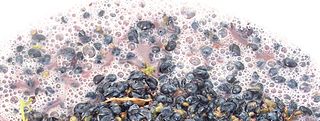
The process of fermentation in winemaking turns grape juice into an alcoholic beverage. During fermentation, yeasts transform sugars present in the juice into ethanol and carbon dioxide. In winemaking, the temperature and speed of fermentation are important considerations as well as the levels of oxygen present in the must at the start of the fermentation. The risk of stuck fermentation and the development of several wine faults can also occur during this stage, which can last anywhere from 5 to 14 days for primary fermentation and potentially another 5 to 10 days for a secondary fermentation. Fermentation may be done in stainless steel tanks, which is common with many white wines like Riesling, in an open wooden vat, inside a wine barrel and inside the wine bottle itself as in the production of many sparkling wines.
Governo is a winemaking technique reportedly invented in Tuscany in the 14th century to help complete fermentation and stabilize the wine. The technique involves saving a batch of harvested grapes and allowing them to partially dry. If fermentation of the main batch starts to slow or appears to be nearing stuck fermentation, the half dried grapes are added to the must which then gives the yeast cells a new source of sugar to enliven the batch. From there, the must can be fermented dry or stopped with the wine having a higher level of residual sugar. The process was widely used in the Chianti zones until the advent of temperature controlled fermentation tanks. From Tuscany the technique spread to Marche and Umbria where it is sometimes used today. In the Marche the technique is most often used on wines made from the Verdicchio grape to counteract the grape's natural bitterness and to add some sweetness and frizzante qualities.

Sugars in wine are at the heart of what makes winemaking possible. During the process of fermentation, sugars from wine grapes are broken down and converted by yeast into alcohol (ethanol) and carbon dioxide. Grapes accumulate sugars as they grow on the grapevine through the translocation of sucrose molecules that are produced by photosynthesis from the leaves. During ripening the sucrose molecules are hydrolyzed (separated) by the enzyme invertase into glucose and fructose. By the time of harvest, between 15 and 25% of the grape will be composed of simple sugars. Both glucose and fructose are six-carbon sugars but three-, four-, five- and seven-carbon sugars are also present in the grape. Not all sugars are fermentable with sugars like the five-carbon arabinose, rhamnose and xylose still being present in the wine after fermentation. Very high sugar content will effectively kill the yeast once a certain (high) alcohol content is reached. For these reasons, no wine is ever fermented completely "dry". Sugar's role in dictating the final alcohol content of the wine sometimes encourages winemakers to add sugar during winemaking in a process known as chaptalization solely in order to boost the alcohol content – chaptalization does not increase the sweetness of a wine.
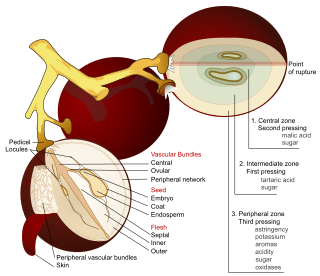
The acids in wine are an important component in both winemaking and the finished product of wine. They are present in both grapes and wine, having direct influences on the color, balance and taste of the wine as well as the growth and vitality of yeast during fermentation and protecting the wine from bacteria. The measure of the amount of acidity in wine is known as the “titratable acidity” or “total acidity”, which refers to the test that yields the total of all acids present, while strength of acidity is measured according to pH, with most wines having a pH between 2.9 and 3.9. Generally, the lower the pH, the higher the acidity in the wine. However, there is no direct connection between total acidity and pH. In wine tasting, the term “acidity” refers to the fresh, tart and sour attributes of the wine which are evaluated in relation to how well the acidity balances out the sweetness and bitter components of the wine such as tannins. Three primary acids are found in wine grapes: tartaric, malic and citric acids. During the course of winemaking and in the finished wines, acetic, butyric, lactic and succinic acids can play significant roles. Most of the acids involved with wine are fixed acids with the notable exception of acetic acid, mostly found in vinegar, which is volatile and can contribute to the wine fault known as volatile acidity. Sometimes, additional acids, such as ascorbic, sorbic and sulfurous acids, are used in winemaking.
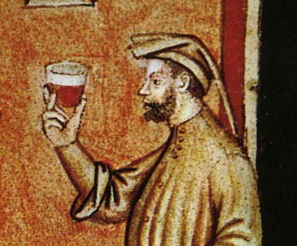
Old World wine refers primarily to wine made in Europe but can also include other regions of the Mediterranean basin with long histories of winemaking such as North Africa and the Near East. The phrase is often used in contrast to "New World wine" which refers primarily to wines from New World wine regions such as the United States, Australia, South America and South Africa. The term "Old World wine" does not refer to a homogeneous style with "Old World wine regions" like Austria, France, Italy, Portugal, and Spain each making vastly different styles of wine even within their own borders. Rather, the term is used to describe general differences in viticulture and winemaking philosophies between the Old World regions where tradition and the role of terroir lead versus the New World where science and the role of the winemaker are more often emphasized. In recent times, the globalization of wine and advent of flying winemakers have lessened the distinction between the two terms with winemakers in one region being able to produce wines that can display the traits of the other region—i.e. an "Old World style" wine being produced in a New World wine region like California or Chile and vice versa.
This glossary of winemaking terms lists some of terms and definitions involved in making wine, fruit wine, and mead.
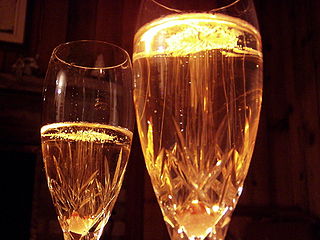
Autolysis in winemaking relates to the complex chemical reactions that take place when a wine spends time in contact with the lees, or dead yeast cells, after fermentation. While for some wines autolysis is undesirable, it is a vital component in shaping the flavors and mouth feel associated with premium Champagne production. The practice of leaving a wine to age on its lees has a long history in winemaking dating back to Roman winemaking. The chemical process and details of autolysis were not originally understood scientifically, but the positive effects such as a creamy mouthfeel, breadlike and floral aromas, and reduced astringency were noticed early in the history of wine.

In winemaking, clarification and stabilization are the processes by which insoluble matter suspended in the wine is removed before bottling. This matter may include dead yeast cells (lees), bacteria, tartrates, proteins, pectins, various tannins and other phenolic compounds, as well as pieces of grape skin, pulp, stems and gums. Clarification and stabilization may involve fining, filtration, centrifugation, flotation, refrigeration, pasteurization, and/or barrel maturation and racking.

The role of yeast in winemaking is the most important element that distinguishes wine from grape juice. In the absence of oxygen, yeast converts the sugars of wine grapes into alcohol and carbon dioxide through the process of fermentation. The more sugars in the grapes, the higher the potential alcohol level of the wine if the yeast are allowed to carry out fermentation to dryness. Sometimes winemakers will stop fermentation early in order to leave some residual sugars and sweetness in the wine such as with dessert wines. This can be achieved by dropping fermentation temperatures to the point where the yeast are inactive, sterile filtering the wine to remove the yeast or fortification with brandy or neutral spirits to kill off the yeast cells. If fermentation is unintentionally stopped, such as when the yeasts become exhausted of available nutrients and the wine has not yet reached dryness, this is considered a stuck fermentation.

Yeast assimilable nitrogen or YAN is the combination of Free Amino Nitrogen (FAN), ammonia (NH3) and ammonium (NH4+) that is available for the wine yeast Saccharomyces cerevisiae to use during fermentation. Outside of the fermentable sugars glucose and fructose, nitrogen is the most important nutrient needed to carry out a successful fermentation that doesn't end prior to the intended point of dryness or sees the development of off-odors and related wine faults. To this extent winemakers will often supplement the available YAN resources with nitrogen additives such as diammonium phosphate (DAP).

